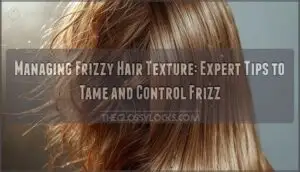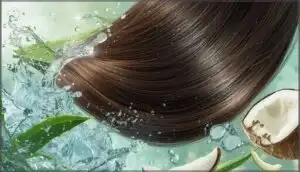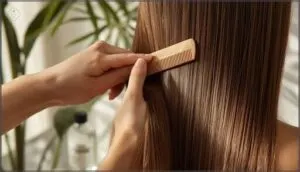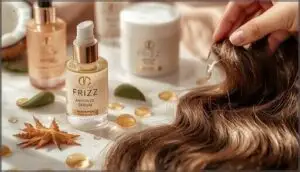This site is supported by our readers. We may earn a commission, at no cost to you, if you purchase through links.

Your hair looks perfect when you leave the house—until you step outside. Within minutes, smooth strands transform into a halo of flyaways, defying every product you’ve applied. This isn’t a personal failing or bad luck; it’s physics meeting biology.
Managing frizzy hair texture requires understanding how moisture penetrates your hair shaft and why some strands rebel against even the most expensive serums. The culprit often lies in your hair’s porosity level, which determines how it reacts to humidity, heat, and the products you trust to tame it.
Once you decode what your hair actually needs—not what marketing promises claim it needs—you can build a routine that works with your texture instead of fighting against it.
Table Of Contents
Key Takeaways
- Frizz happens when humidity above 60% penetrates your hair shaft and lifts the cuticle, with your genetic hair porosity determining how vulnerable you are to moisture chaos.
- Heat above 237°C and chemical treatments destroy keratin structure and spike porosity by 35%, making damage prevention through heat protectants and sulfate-free products non-negotiable.
- Your washing frequency, drying method, and product choices matter more than expensive serums—overwashing strips natural oils while microfiber towels and leave-in conditioners cut frizz by up to 40%.
- Professional keratin treatments offer six months of frizz control by filling hair shaft gaps and sealing cuticles, delivering results that daily routines alone can’t match.
Causes of Frizzy Hair Texture
Frizz doesn’t just happen—it’s your hair reacting to specific triggers that disrupt its natural structure. Understanding what causes your strands to rebel is the first step toward taking back control.
Let’s break down the four main culprits that turn smooth hair into a frizzy mess.
Humidity and Environmental Factors
When humidity spikes—especially above 60%—water molecules penetrate your hair shaft, disrupting styled bonds and lifting the cuticle. Climate change intensifies these frizz patterns, while air pollution in urban areas degrades cuticle integrity by up to 40%. Geographic variations matter too:
- Tropical regions face 80%+ humidity during wet seasons
- Indoor steam creates localized frizz zones year-round
- Humidity-resistant spray shields against moisture penetration
Understanding the hair frizz causes is key to managing frizzy hair texture. Master humidity control for lasting frizz control.
Hair Porosity and Genetics
Your genetics shape your hair fiber structure and cuticle integrity from birth. Variations in genes like EDAR and TCHH determine whether you’ve got straight, wavy, or coily strands—and coily hair types naturally have higher porosity, absorbing water fast but losing moisture even faster. That’s the frizz genetics at play.
Porosity testing reveals how your cuticle lifts, making curly and textured hair more vulnerable to environmental chaos. Understanding hair porosity factors is essential in managing frizzy hair texture.
Damage From Heat and Chemicals
Flat irons and chemical straighteners don’t just style your hair—they strip it bare. When heat climbs above 237°C, your hair’s α-keratin breaks down, and the cuticle cracks under the assault. Chemical treatments spike porosity by 35%, leaving strands thirsty and brittle. Without a heat protectant, you’re inviting cuticle degradation and fiber fatigue with every pass.
Heat above 237°C and chemical treatments break down keratin, crack cuticles, and spike porosity by 35%, leaving hair brittle without protection
- Heat styling above 200°C fractures your hair’s protein backbone
- Chemical treatments destroy tensile strength and accelerate breakage
- Porosity increase from damage makes moisture retention nearly impossible
- Fiber fatigue builds silently until your strands snap under routine tension
Overwashing and Harsh Products
Your hair care routine might be the villain. Overwashing effects strip natural sebum, leaving strands brittle and screaming for moisture. Sulfates and drying alcohols—harsh ingredient risks hiding in your shampoo—rip through the cuticle like sandpaper.
Switch to a sulfate-free shampoo and moisturizing shampoo that respect scalp balance. Gentle cleansing protects hair porosity treatment efforts and keeps frizzy hair from staging a rebellion.
Preventing Frizz in Daily Hair Care
You can’t wrestle frizz into submission once it’s already taken over—you have to stop it before it starts. That means rethinking your daily routine, from what you’re putting on your hair to how you’re handling it when it’s wet.
Here’s how to build a bulletproof defense against frizz that actually works.
Choosing The Right Shampoo and Conditioner
Your cleansing routine sets the stage for everything that follows. Sulfate-free shampoos won’t strip your hair’s natural oils, while moisturizing conditioners with cationic surfactants reduce friction and flyaways by over 70%.
Look for gentle cleansers packed with natural ingredients like argan oil, shea butter, or jackfruit extract—they’ll nourish without weighing hair down, giving you real frizz control products that deliver results.
Proper Washing Frequency
Too much washing strips your scalp’s natural oils, which ironically makes frizz worse. If you’ve got wavy or curly frizzy hair, aim for one to two washes per week—this washing schedule maintains scalp balance and moisture retention. Coarser textures benefit from even less: once weekly keeps hair hydration locked in.
These hair care tips prevent the dryness that amplifies frizz, especially in humidity.
Gentle Drying Techniques
Ditch the aggressive rubbing—you’re wrecking your cuticle. Switch to a microfiber towel and gently blot water out instead. This cuts frizz by up to 40% and slashes breakage.
Want even more frizz control? Air dry until you’re halfway there, then finish with a diffuser on low heat, keeping it an inch away. Always apply a leave-in conditioner first for moisture lock and silky results.
Regular Trims and Maintenance
Split ends are frizz magnets—they unravel your entire strand and sabotage every styling effort. Your trim frequency shapes your hair texture more than you realize. Here’s your maintenance routine for frizz reduction:
- Fine hair: Regular haircuts every 6-8 weeks prevent damage spread
- Medium-thick: Trim every 8-12 weeks for ideal hair care
- Curly/coily: 10-12 week intervals stop tangling
- Heat-damaged: Return every 6-8 weeks for frizzy hair solutions
Hydration and Moisture Retention Tips
Your hair can’t fight frizz if it’s running on empty. The key to long-term control isn’t just what you put on your hair—it’s how well you lock that moisture in and keep it there.
Here’s how to build a hydration routine that actually sticks.
Deep Conditioning Treatments
Deep conditioning is your secret weapon for locking moisture into your hair and reducing frizz from the inside out. This intensive hair nourishment penetrates deeper than regular conditioners, sealing your cuticle and giving you lasting softness and control.
Apply a rich, protein-enriched treatment once a week—from mid-length to ends—to nourish, repair, and strengthen damaged strands. Curly or color-treated hair? You might need twice-weekly sessions initially.
Leave-in Conditioners and Oils
Leave-in conditioners and oils are your daily armor against frizz—they lock in moisture, smooth the cuticle, and create a protective shield that humidity can’t penetrate. Choose lightweight formulas for fine hair or richer oils like argan and coconut for thicker textures.
- Apply leave-in products to damp hair for maximum moisture locking and frizz control techniques
- Focus oil on your ends to seal split ends and boost hair smoothing
- Match your leavein conditioner to your hair porosity—low porosity needs lighter formulas
- Use hair oil as a finishing touch for shine and humidity resistance
- Reapply throughout the day to tame flyaways and maintain hair moisture
Cold Water Rinses for Cuticle Sealing
Cold water rinses won’t magically seal your hair cuticle—that’s a myth—but they can temporarily smooth the surface for a shinier, less frizzy finish. The real power lies in pH-balanced products that flatten the cuticle chemically.
Still, a quick 30-second cold rinse after conditioning helps with frizz reduction and preserves your scalp’s natural oils, supporting overall scalp health without stripping moisture.
Avoiding Dehydrating Ingredients
Beyond temperature tricks, you need to dodge ingredients that sabotage hair moisture retention. Sulfate effects include stripped natural oils—sodium lauryl sulfate dries out strands fast. Paraben risks involve hormonal concerns plus brittleness. Silicone buildup blocks hydration, while mineral oil suffocates hair. Fragrance irritants inflame your scalp.
Switch to sulfate-free shampoo and prioritize deep conditioning with hydrating shampoo formulas. These hair hydration methods protect your cuticle instead of destroying it.
Styling Techniques for Frizz Control
You’ve hydrated your hair—now it’s time to lock in that moisture and keep frizz at bay while you style.
The right techniques can make the difference between hair that fights you all day and hair that stays smooth and controlled. Here’s how to approach styling when frizz is your biggest challenge.
Air Drying and Diffusing Methods
Your drying technique can make or break your frizz battle. Air drying works best when you gently squeeze—never rub—excess water with a microfiber towel, then apply a humidity-resistant spray to seal your cuticle before it lifts.
Prefer speed? A diffuser on low heat sets your hair texture faster while locking in moisture. Either way, less manipulation means smoother results and real frizz prevention.
Detangling and Combing Strategies
Once your hair’s dry, detangling becomes your next frizz prevention checkpoint. Start at the ends and work upward with a wide-tooth comb—never brute-force from roots down. This gentle styling approach cuts hair breakage and keeps cuticles flat.
Follow these detangling tips for smoother results:
- Apply leave-in conditioner or detangling spray for slip before combing
- Divide thick hair into sections to control force and minimize strain
- Use finger detangling for curly textures to reduce mechanical stress
Patience here pays off in hair texture management and long-term smoothness.
Anti-Frizz Creams and Serums
After detangling, you’ll need targeted hair care products to lock in smoothness. These hair smoothing techniques create a protective barrier that tames unruly strands.
Apply anti-frizz creams or serums to damp hair—mid-lengths to ends—for maximum frizz control and serum benefits. Cream application works best when you distribute product evenly, avoiding roots.
Product reviews consistently highlight serums with natural oils for excellent hair texture management.
Humidity-Resistant Styling Products
When moisture invades your finished style, humidity-resistant spray becomes your frontline defense. These hair styling products create a flexible shield that blocks environmental moisture while maintaining natural movement.
Look for formulations with film-forming polymers—they’re proven anti-frizz weapons in high-humidity climates. Apply to dry, styled hair for lasting frizz control methods that preserve your hair smoothing techniques through unpredictable weather conditions.
Advanced Solutions and Professional Treatments
Sometimes your everyday routine hits a wall, and that’s when it’s time to bring in the professionals. Sophisticated treatments and expert-level products can tackle stubborn frizz in ways at-home care just can’t match.
Here’s what you need to know about the solutions that deliver real, lasting results.
Keratin and Smoothing Treatments
When frizz feels unbeatable, professional keratin treatments offer a game-changing solution. These treatments fill gaps in your hair shaft and seal the cuticle, delivering up to six months of frizz reduction while cutting styling time in half.
Think of it as armor against humidity—your hair gains smoothness, shine, and manageability that daily products alone can’t achieve. Keratin benefits transform coarse, unruly strands into sleek, manageable hair.
Haircuts for Texture Management
The right cut can transform your fight against frizz by working with your hair texture instead of against it. Strategic layering and texturizing techniques reduce bulk while distributing weight, letting your hair breathe and move naturally.
Here are some effective styles to consider:
- Layered lobs and shags add movement without overwhelming texture, perfect for natural waves.
- U-cuts at collarbone length lighten thick, wavy hair prone to puffiness.
- Textured bobs soften the jawline while managing fine to medium wavy hair.
- Long layers prevent weight-induced puffiness, supporting smoother flow.
- Pixie cuts drastically minimize frizz through reduced hair length and volume.
Regular trims every six to eight weeks prevent split ends that worsen frizz, keeping your styling options manageable and your look polished.
Professional Product Recommendations
You need salon-grade formulas to truly dismantle frizz, not drugstore guesswork. Product reviews and ingredient analysis reveal that brands like Moroccanoil, Redken, and IGK dominate with keratin-infused serums and humidity-resistant sprays offering 96-hour protection.
User experiences confirm these hair styling products deliver—Paul Mitchell’s smoothing system and heat protectants with argan oil shield against environmental damage.
Brand comparisons and formula innovations prove professional frizzy hair solutions outperform standard options consistently.
Market Trends in Anti-Frizz Hair Care
Market Growth in anti-frizz hair care is exploding—projected to hit USD 12 billion by 2034. Consumer Preferences now demand vegan, silicone-free formulas with clinical proof. Product Innovation delivers AI-driven diagnostics and biotech alternatives for frizzy hair solutions.
Ecommerce Trends and subscription models dominate distribution, while Sustainability Efforts reshape packaging.
You’ll see humidity-resistant spray technology and keratin complexes leading hair styling advice, offering serious hair protection against environmental chaos.
Frequently Asked Questions (FAQs)
Can diet or nutrition help reduce frizz?
Like fuel for an engine, your diet powers hair health from within. Hydration benefits, omega-3 effects, and vitamin intake—especially protein sources rich in biotin—support hair texture, while antioxidant role strengthens cuticles, reducing frizz naturally through improved hair nutrition and hydration.
Does hard water make hair more frizzy?
Hard water causes mineral buildup on your hair shaft, blocking moisture and creating frizz.
Install a water softening filter and use clarifying shampoos weekly to restore scalp health and improve hair texture control.
How do silk pillowcases prevent frizz overnight?
Silk fabric benefits your hair texture by reducing friction up to 43% compared to cotton. This cuticle protection preserves moisture retention overnight, preventing frizz reduction techniques damage.
Sleep haircare becomes seamless when hair health improves naturally.
Are there specific vitamins for frizz reduction?
You might think topicals do all the work, but nutrition matters. Vitamin A benefits sebum production, while Vitamin E supplements and Biotin intake strengthen strands.
Vitamin C function aids collagen, and Vitamin D effects improve follicle health, reducing frizzy hair texture.
Can scalp health affect hair frizz levels?
Absolutely. Scalp health directly impacts frizz levels through sebum balance and cuticle integrity. When your scalp lacks proper hydration or experiences inflammation, hair shafts weaken and swell, making frizz prevention nearly impossible without targeted scalp therapy.
Conclusion
The difference between frizz that owns you and frizz you command isn’t a miracle product—it’s knowledge applied with precision.
Managing frizzy hair texture becomes second nature once you stop guessing and start responding to what your strands actually communicate. Your porosity dictates your protocol. Your environment shapes your strategy.
Master these variables, and you’ll never again leave the house wondering if your hair will betray you before lunch.
- https://www.pureology.com/hair-care/smooth-perfection-shampoo-anti-frizz-hair-smoothing.html?dwvar_smooth-perfection-shampoo-anti-frizz-hair-smoothing_size=1L%20%2F%2033.8%20fl%20oz
- https://www.kerastase-usa.com/collections/discipline/maskeratine-hair-mask.html
- https://www.biolage.com/collections/smooth-proof/smooth-proof-leave-in-cream
- https://www.aad.org/public/diseases/hair-loss/insider/stop-damage
- https://medlineplus.gov/genetics/understanding/traits/hairtexture/










